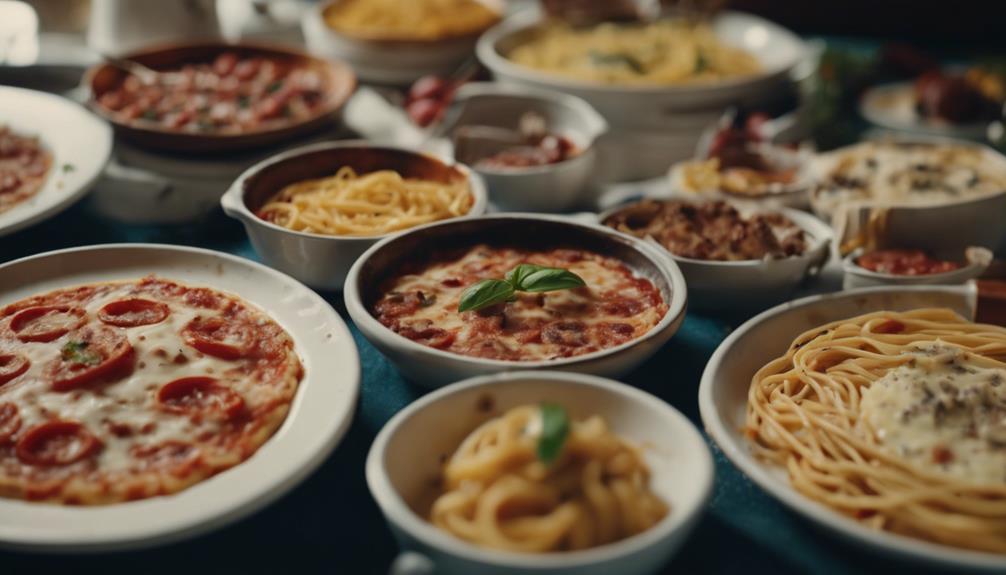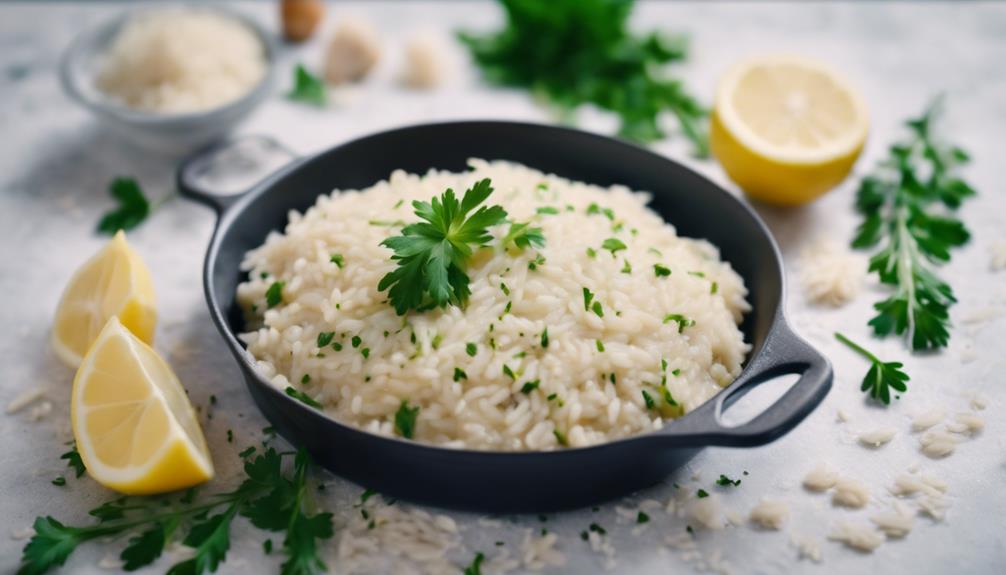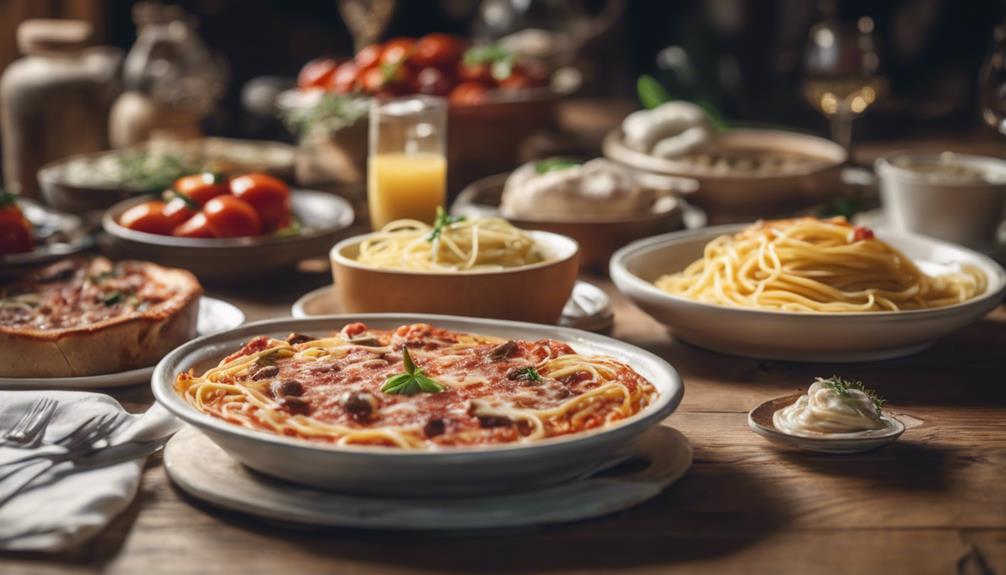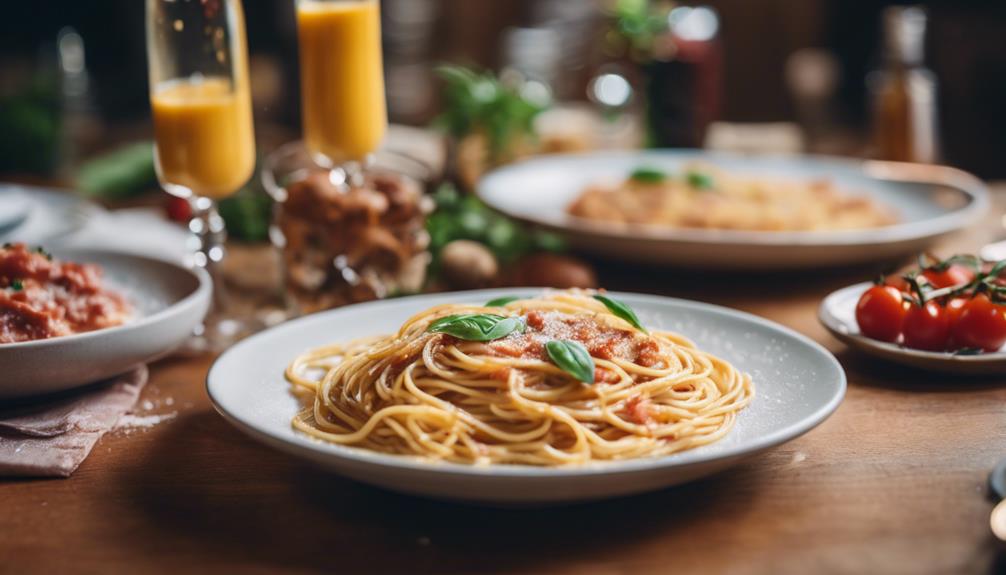Italian cuisine offers a wide range of flavorful dishes that are sure to satisfy your taste buds. From creamy risotto with its regional variations to the deliciousness of Neapolitan pizza, each bite is like embarking on a culinary adventure. Don’t forget to indulge in the comforting taste of pasta, with over 300 types to choose from. Enjoy the soft texture of handmade gnocchi, which adds a touch of tradition to your dish. And who can resist the bold flavors of Pesto Alla Genovese? These dishes are just the beginning of a delectable journey through Italy’s culinary world. Are you ready to explore even more temptations?
Key Takeaways
- Risotto: Creamy rice dish with regional variations.
- Pizza: Culinary masterpiece with diverse toppings.
- Pasta: Beloved Italian tradition with various shapes.
- Gnocchi: Handmade potato dumplings for rich experience.
- Gelato: Classic Italian dessert with rich, creamy flavors.
Risotto
If you're a fan of creamy and flavorful rice dishes, Risotto is a must-try Italian classic originating from Northern Italy. This delectable dish hails from the northern areas of Italy, where the cool climate and rich culinary traditions have influenced its creation.
Risotto is renowned for its luxurious, creamy texture that melts in your mouth with every bite, making it a favorite among food enthusiasts worldwide.
In Italy, different regions have their own unique take on risotto, incorporating a variety of ingredients such as seafood, mushrooms, or vegetables to enhance the dish's flavor profile. The key to achieving the perfect risotto lies in the choice of rice – popular varieties like Arborio, Carnaroli, and Vialone Nano are prized for their ability to absorb liquid while maintaining a firm texture.
Whether enjoyed as a main course or a side dish, risotto never fails to impress with its rich taste and comforting consistency.
Pizza

So, you think you know pizza?
Let's talk about the fascinating origins and evolution of this beloved dish.
The diverse regional variations make it unique, and the most popular toppings keep us coming back for more.
Get ready to uncover the delicious secrets behind the world's favorite Italian creation!
Pizza Origins and Evolution
Pizza, originating in Naples, Italy in the 18th century, started as a simple flatbread topped with tomato, mozzarella, and basil. This traditional Italian dish, known as Margherita pizza, pays homage to Queen Margherita of Savoy with its colors resembling the Italian flag.
Over time, pizza evolved into a culinary masterpiece with a myriad of toppings and styles worldwide. Despite the global variations, Neapolitan pizza remains a symbol of Italian gastronomy, with specific guidelines to maintain its authenticity.
The meticulous art of crafting Neapolitan pizza has even earned recognition from UNESCO as an Intangible Cultural Heritage, highlighting its cultural significance and unique preparation methods.
From the streets of Naples to the bustling pizzerias around the world, pizza has transcended borders to become a beloved icon of Italian cuisine, blending tradition with innovation in a deliciously crispy and cheesy way.
Regional Pizza Variations
Explore the diverse regional variations of pizza found throughout Italy, each showcasing unique styles, crusts, and toppings that capture the essence of their specific culinary traditions. Neapolitan pizza, originating in Naples, is renowned for its soft, chewy crust and minimalist toppings, as seen in the classic pizza Margherita with tomatoes, mozzarella, basil, and olive oil. On the other hand, Sicilian pizza boasts a thick, airy base that can hold a generous amount of toppings, creating a satisfying and hearty meal.
Different regions in Italy have their own twist on this beloved dish. Roman pizza stands out for its thin, crispy crust that provides the perfect base for an array of toppings. Coastal areas often feature seafood on their pizzas, while regions like Parma might opt for delicious prosciutto as a topping.
It's fascinating how each region's pizza reflects its local ingredients and culinary heritage, making every bite a unique experience.
Popular Pizza Toppings
What are some of the most popular pizza toppings enjoyed in Italy? Italians take their pizza seriously, and the toppings play an essential role in creating the perfect pie. From the classic Margherita to the flavorful Funghi, there are numerous options to satisfy your pizza cravings. Let's take a look at some popular pizza toppings in Italy:
| Pizza Topping | Description |
|---|---|
| Margherita | Tomato sauce, mozzarella cheese, fresh basil |
| Pepperoni | Spicy cured sausage slices |
| Funghi | Mix of flavorful mushrooms like porcini, cremini, or shiitake |
Each topping brings its unique flavor profile to the pizza, whether you prefer the simplicity of Margherita or the boldness of Pepperoni. So, next time you're ordering a pizza in Italy, consider trying one of these popular toppings to experience authentic Italian flavors.
Pasta
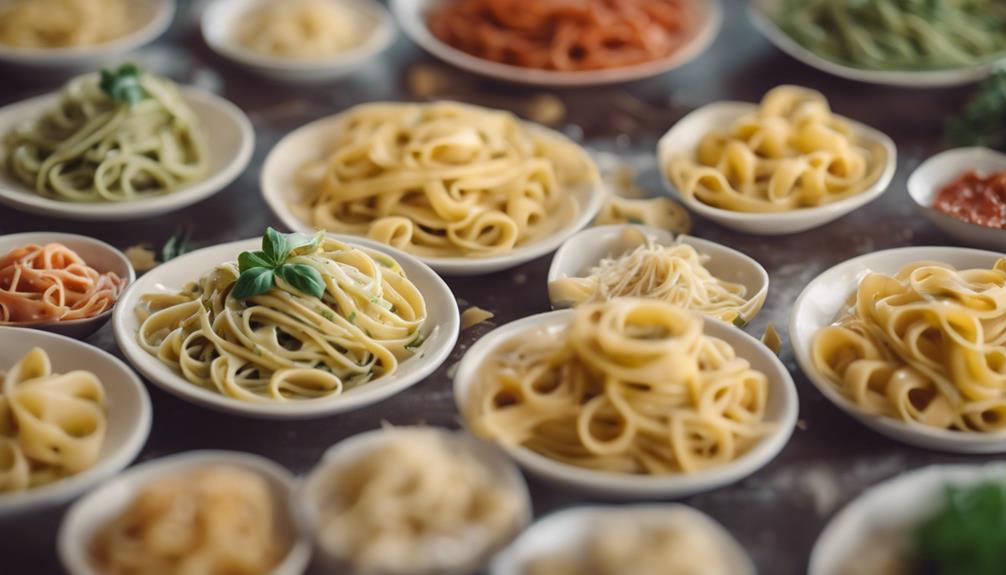
Explore the world of Italian pasta, a beloved culinary tradition that offers a myriad of delicious options. Italian pasta is a cornerstone of the country's cuisine, with famous dishes like spaghetti, fettuccine, and penne gracing tables worldwide.
These pasta dishes come in various forms, from the creamy carbonara to the rich bolognese and the light pomodoro sauces, catering to every palate. Made from durum wheat semolina flour and water, Italian pasta provides a satisfying and comforting meal that's cherished by many.
Italy takes pride in its pasta culture, boasting over 300 types of pasta, each region showcasing unique shapes and sauces for a diverse culinary experience. Whether enjoyed as a primo (first course) or as a main course, pasta dishes exemplify the artistry and creativity of Italian cooking, making them a must-try for any food enthusiast.
Gnocchi
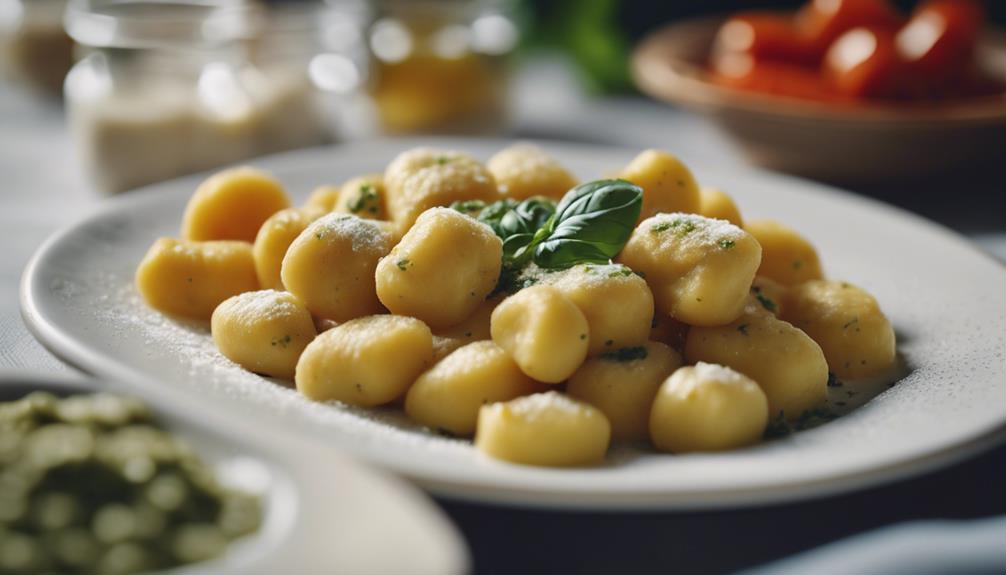
Gnocchi, a popular alternative to pasta in Italian cuisine, offers a traditional and comforting dining experience, often handmade by grandmothers across Italy. These soft, pillowy potato dumplings serve as a delightful canvas for a plethora of pasta sauces, from tangy tomato to creamy alfredo, providing a diverse range of flavors to tantalize your taste buds.
Unlike traditional pasta dishes, gnocchi boasts a unique texture that sets it apart, making each bite a culinary adventure.
Whether you prefer your gnocchi served with a simple tomato sauce for a classic taste or a rich cream sauce for a decadent treat, this versatile Italian dish never fails to satisfy. Its handmade quality and rich history add an extra layer of charm to the dining experience, transporting you to the cozy kitchens of Italian grandmothers with every bite.
Pesto Alla Genovese
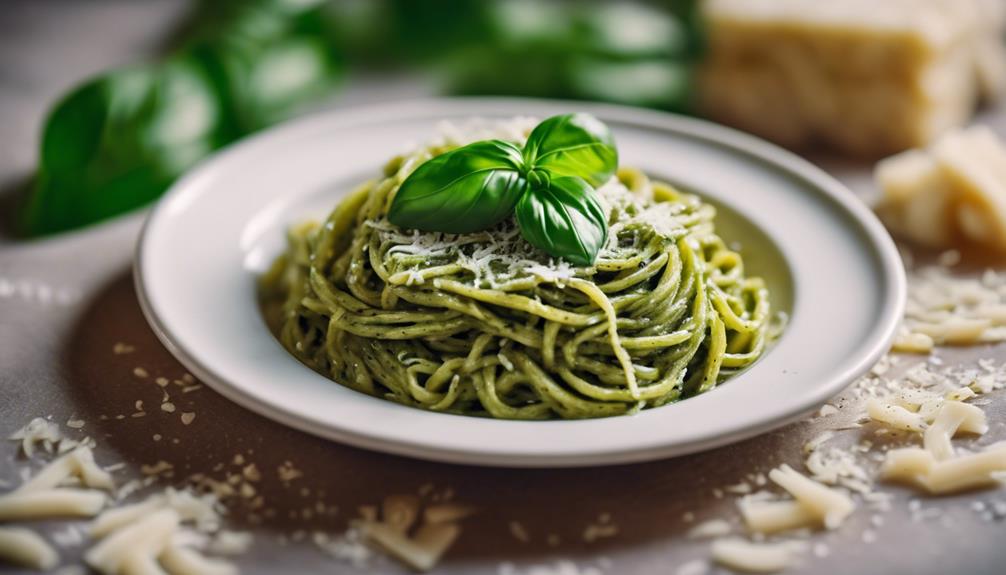
Indulge in the vibrant flavors of Pesto Alla Genovese, a traditional sauce hailing from Genoa, Italy. This iconic sauce is a staple in Italian cuisine, known for its fresh basil, Parmesan cheese, pine nuts, garlic, and olive oil. The combination of these high-quality ingredients creates a sauce with a vibrant green color and an aromatic flavor that's beloved worldwide.
Pesto Alla Genovese is incredibly versatile and can be enjoyed in various ways. It's commonly served over pasta such as trofie or mixed with potatoes in the classic dish 'patate al pesto.' The rich and creamy texture of the sauce, along with the nutty undertones from the pine nuts, makes it a favorite among food enthusiasts.
Whether you're a fan of Italian cuisine or simply looking to add a burst of flavor to your meals, Pesto Alla Genovese is sure to impress your taste buds. Get ready to experience the deliciousness of this classic condiment that has stood the test of time in the culinary world.
Lasagne

Lasagne embodies the essence of indulgent comfort with its layers of pasta, rich bolognese sauce, creamy bechamel, and gooey cheese. Originating from Bologna, Italy, this classic dish is a hearty favorite enjoyed worldwide for its delicious flavors.
The meaty bolognese sauce adds a savory depth to each bite, perfectly complemented by the velvety smoothness of the bechamel sauce. The generous sprinkling of cheese over the top creates a golden crust that promises a delightful combination of crispy and creamy textures in every mouthful.
Whether served at family gatherings or special occasions, lasagne holds a special place in Italian cuisine. Its versatility allows for creative additions such as vegetables, mushrooms, or different meats, making it a customizable dish that suits various tastes.
The satisfaction of digging into a steaming hot portion of lasagne, with its layers of goodness melding together in perfect harmony, is truly a culinary experience worth savoring.
Gelato

Love gelato? Get ready to explore the delightful world of this Italian frozen treat!
From classic flavors like pistachio and chocolate to unique creations such as stracciatella and tiramisu, gelato offers a wide range of delicious options.
Gelato Flavors
For gelato enthusiasts seeking a delightful range of flavors, Italian gelaterias offer a tempting selection to satisfy your cravings. Traditional Italian gelato is renowned for its rich and creamy texture, making it a favorite dessert around the world.
When you step into a gelato shop in Italy, you'll be greeted with a dazzling array of flavors to choose from. Some classic options include the timeless pistachio, indulgent chocolate, and comforting vanilla. But the magic doesn't stop there! Italian gelato makers have also crafted unique flavors like the decadent tiramisu, the invigorating stracciatella (chocolate chip), and the nutty hazelnut.
- Pistachio
- Chocolate
- Vanilla
These flavors, along with many others, are carefully prepared using milk, sugar, and various flavorings, resulting in a denser and smoother consistency compared to ice cream.
Whether you prefer sticking to the classics or adventuring into new flavor territories, there's a gelato flavor for every palate waiting to be savored in Italy.
Gelato History
When exploring the origins of gelato, it becomes evident that this traditional Italian dessert has a rich history dating back to the Renaissance period in Florence. Gelato, different from regular ice cream with its denser and creamier texture, originated in the beautiful city of Florence during a time of great artistic and cultural innovation.
This delightful treat is known for containing less air and fat than ice cream, resulting in a more intense and flavorful experience for your taste buds. The main ingredients for gelato typically include milk, sugar, and a variety of natural flavors such as fruits, nuts, or chocolate, making it a versatile and scrumptious dessert option.
During the Renaissance period in Florence, gelato was enjoyed by the elite and quickly became a symbol of sophistication and indulgence. The art of making gelato has been passed down through generations, preserving its traditional methods and delicious taste.
Gelato Serving Tips
Enhance your gelato experience by considering these simple serving tips.
- Let it Soften: Allow your gelato to sit out for a few minutes before digging in. This helps enhance the creamy texture and allows the flavors to fully develop.
- Use a Spade: Opt for a spade-like spoon rather than a traditional ice cream scoop. The flat surface of the spade helps you scoop the gelato smoothly without squishing it.
- Mix and Match Flavors: Don't be afraid to mix and match different gelato flavors for a unique taste experience. Pair a classic like stracciatella with a fruity flavor like lemon for a delightful combination that tantalizes your taste buds.
Prosciutto Di Parma

Prosciutto Di Parma, renowned Italian cured meat, is made from specially bred pigs in the Parma region. This delectable delicacy is aged for a minimum of 12 months, ensuring a delicate and flavorful taste that's unrivaled. Protected under the PDO status, Prosciutto di Parma guarantees authenticity and superior quality that's a reflection of its rich heritage.
In Italian cuisine, Prosciutto di Parma holds a special place, often gracing tables as a sophisticated antipasto. The thinly sliced perfection of this cured meat pairs exquisitely with melon or figs, offering a delightful mix of sweet and savory flavors that tantalize the taste buds.
Considered a symbol of culinary excellence, Prosciutto di Parma isn't just food; it's an experience. Its presence elevates any dish it accompanies, adding a touch of elegance and tradition to every bite.
Ribollita

Hey there, now let's talk about Ribollita! This traditional Tuscan soup is a real gem, packed with veggies, beans, and a touch of olive oil.
Get ready to learn all about the Ribollita recipe and its fascinating origins.
Let's uncover the delicious secrets behind this hearty, frugal, and sustainable Italian dish!
Ribollita Recipe
Dating back to the Middle Ages, Ribollita is a traditional Tuscan soup known for its hearty combination of cannellini beans, kale, bread, and vegetables. If you're looking to try your hand at this classic Italian dish, follow this simple Ribollita recipe:
- Ingredients:
- Cannellini beans
- Kale
- Bread
To begin, soak the cannellini beans overnight and then cook them until tender. In a separate pot, sauté kale and other vegetables of your choice. Next, add the cooked beans to the vegetable mixture and let the flavors meld together.
- Method:
- Soak beans overnight
- Cook beans until tender
- Sauté kale and vegetables
Once everything is cooked, tear stale bread into chunks and add it to the soup, allowing it to thicken and absorb the delicious flavors. Remember, Ribollita tastes even better the next day when the flavors have had time to meld together, so make a big batch and enjoy it over a few days!
Ribollita Origins
Originating in the Middle Ages in Tuscany, Ribollita is a traditional soup known for its sustainability and hearty ingredients. This Tuscan dish was cleverly crafted to make the most out of leftovers, combining bread and vegetables into a rich and flavorful meal.
The name 'Ribollita' itself, meaning 'reboiled,' hints at the practice of reheating the soup to intensify its delicious flavors. This hearty soup usually features a medley of cannellini beans, kale, cabbage, and carrots, creating a nutritious and satisfying dish that warms the soul.
The thick and stew-like consistency of Ribollita adds to its comforting appeal, making it a popular choice, particularly during colder seasons.
Bagna Cauda
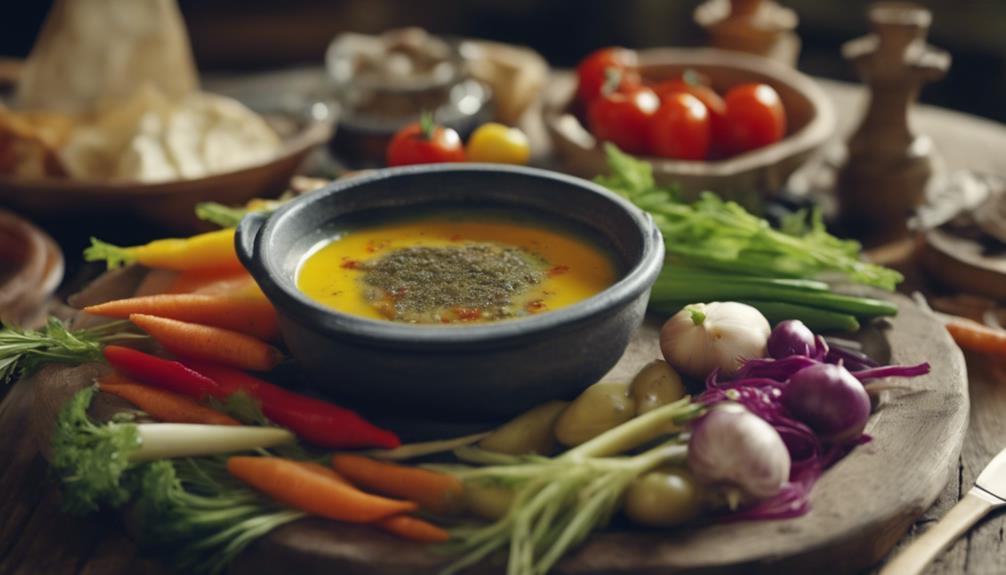
A traditional Piedmontese dish, Bagna Cauda is a savory blend of olive oil, garlic, and anchovies, commonly enjoyed as a warm dip for vegetables. This appetizer hails from Northern Italy and is a beloved part of the region's culinary heritage.
- Rich Flavor Profile: The combination of olive oil, garlic, and anchovies creates a flavorful and indulgent experience for your taste buds.
- Perfect for Cold Weather: Bagna Cauda is especially popular during the colder months, making it a comforting choice for festive gatherings and cozy dinners.
- Showcasing Piedmontese Flavors: This dish perfectly showcases the regional flavors of Piedmont, highlighting the ingredients and culinary traditions of the area.
The name 'Bagna Cauda' translates to 'hot bath' or 'hot sauce' in Italian, reflecting the warm and comforting nature of this dish.
Whether you're a fan of anchovies or looking to explore traditional Piedmontese cuisine, Bagna Cauda is a must-try for any food enthusiast.
Frequently Asked Questions
What Are 5 Popular Italian Foods?
When it comes to popular Italian foods, you've got a delicious array to choose from. Classics like Pizza Margherita, Pasta Carbonara, Risotto, Tiramisu, and Gelato are sure to satisfy your cravings for Italian cuisine.
What Is the Number One Food in Italy?
In Italy, pizza reigns supreme as the number one food, a cultural symbol cherished by locals and visitors alike. Indulge in its rich history and diverse flavors, from classic Margherita to gourmet creations.
What Is the National Dish of Italy?
Pasta is the national dish of Italy, a beloved staple enjoyed in diverse forms. From spaghetti carbonara to lasagne, Italy's culinary heritage shines through iconic pasta dishes. Indulge in regional specialties for a taste of tradition.
What Is the Tastiest Italian Dish?
When looking for the tastiest Italian dish, consider the rich and indulgent flavor of Risotto. Its creamy texture, cooked with wine and stock, offers a comforting experience that many find irresistible. Why not give it a try?
What Italian Dishes Are Most Popular According to Santino’s Italian Cuisine Menu?
Santino’s Italian Cuisine Menu offers a variety of popular Italian dishes, including classics like spaghetti carbonara, lasagna, and gnocchi. All these mouthwatering options on the Santino’s Italian Cuisine Menu are made with authentic Italian ingredients and traditional recipes, ensuring a delightful dining experience for every customer.
Conclusion
To sum up, when it comes to popular Italian dishes, risotto, pizza, pasta, gnocchi, pesto alla Genovese, gelato, prosciutto di Parma, ribollita, and bagna cauda reign supreme.
Whether you're craving a creamy rice dish, a cheesy pizza, or a comforting bowl of pasta, Italian cuisine has something for everyone.
So next time you're looking for a delicious meal that will transport you to the streets of Italy, be sure to try one of these mouthwatering classics.
Buon appetito!
